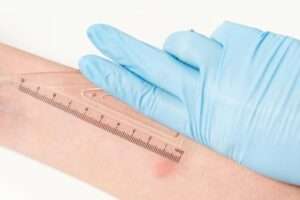As the weather warms up, you and your family will probably be spending more time enjoying the great outdoors. After all, the summer brings more opportunities for you to camp, hike, swim and bike. Before going outside, though, be sure to protect yourself from Lyme disease this summer.
In 2015, 95% of lyme disease cases came from just 14 states: Connecticut, Delaware, Maine, Maryland, Massachusetts, Minnesota, New Hampshire, New Jersey, New York, Pennsylvania, Rhode Island, Vermont, Virginia and Wisconsin.
What is Lyme disease?
Lyme disease is caused by bacteria called Borrelia burgdorferi and is transmitted to humans through the bite of blacklegged ticks that carry the disease. Typical symptoms include fever, headache, fatigue, and a characteristic skin rash called erythema migrans. If you don’t get urgent treatment, the infection can spread to joints, the heart, and the nervous system. Lyme disease is diagnosed based on symptoms, physical findings (e.g., rash), and the possibility of exposure to infected ticks; laboratory testing is helpful if used correctly and performed with validated methods. Most cases of Lyme disease can be treated successfully with a few weeks of antibiotics.
What can you do to protect yourself?
You can decrease the chances of a tick bite with a few precautions.
- Avoid tick-infested areas. This is especially important in May, June and July. Many local health departments and park or extension services will have information regarding these areas.
- If you are in a tick-infested area, walk in the center of trails to avoid contact with overgrown grass.
- Use insect repellent. Spray repellent containing a 20%-30% concentration of DEET on clothes and on exposed skin.
- You can also treat clothes (especially pants, socks and shoes) with permethrin, which kills ticks on contact. Do not use permethrin directly on skin.
- You can also use permethrin on tents and some camping gear.
- Always check for ticks after being outdoors, even in your own yard.
- Remove attached ticks with tweezers. Avoid crushing the tick’s body. Grasp the tick firmly and as close to the skin as possible. Cleanse the area with an antiseptic.
- Bathe or shower as soon as possible after coming indoors (preferably within 2 hours) to wash off and more easily find ticks that are crawling on you.
- After being outdoors, dry clothing in a hot dryer for 10 minutes to kill any ticks that are attached to clothing.
Source: CDC
If you think that you may be ill from a tick bite, you should see a healthcare provider to diagnose your illness. Statcare Urgent Medical Care is a great option for tick prevention advice, Lyme Disease testing and treatment. No appointment is necessary at our clinics and you’ll only wait minutes to be seen. You can call ahead at (917) 310-3371 and let us know you’re on the way or you can check in online.










